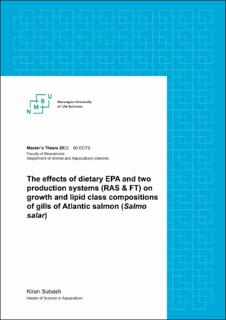| dc.description.abstract | Recirculating aquaculture systems (RAS) are becoming quite common for commercial production of large post smolts, primarily because of their potential for sustainable use of water, better control over culture conditions and greater biosecurity. However, little is known about how dietary lipids affect the salmon’s membrane lipids in RAS compared to fish cultivated in flow through system (FT). In the present study, we compared the growth performance, and gill lipid class composition of Atlantic salmon (Salmo salar) post smolt in RAS and FT systems. Fish in the two systems were held at identical temperatures (12 °C) and fed on the same two diets, either a control diet with commercial relevant level of eicosapentaenoic acid (EPA) or an EPA diet with higher level of this fatty acid. The weight of the fish at the start of the experiment in both systems was 101g and the fish was followed for 76 days to an average final weight of 403,74g in RAS and 437,47g in FT.
We found significantly higher growth rates in FT than in RAS (SGR 1,93 vs1,84). Investigation of apparent digestibility coefficient (ADC) of minerals such as phosphorous (P), calcium (Ca), magnesium (Mg), and zinc (Zn) indicated accumulation of Mg in water in the RAS units.
We also analyzed the gills of A. salmon from the 4 different experimental groups for the total fat content, total fatty acid compositions and composition of different phospholipid classes, including phosphatidylcholine (PC), phosphatidylethanolamine (PE), Phosphatidylserine (PS), phosphatidylinositol (PI) and a combined fraction of Lysophosphatidylcholine + Sphingomyelin (LPC + SM). Further the ratio between the main PL classes was determined. Furthermore, we examined the expression of genes coding for enzymes involved in phospholipid synthesis and remodeling.
The total fatty acid compositions of the gills primarily reflected the fatty acid composition of the diets. For instance, Fish fed with EPA diet had higher levels of EPA and ARA in their gill total lipids and in all phospholipid classes except PS and PI. The production systems and dietary EPA content did not influence the total fat percentage of gill tissue of Atlantic salmon.
However, the relative composition of several fatty acids in the gills, especially polyunsaturated fatty acids (PUFA) showed significant differences between the production systems. Compared to the gills of fish in FT, fills of fish in RAS had higher arachidonic acid (ARA) (11-15%) in total fatty acid composition. While in phospholipid classes, gills of fish in RAS had lower (6-9%) EPA in PC, lower (11-13%) EPA and lower (5-13%) ARA in PE, PS of fish in RAS had lower (6-12%) DHA and PI had lower (14-29%) ARA. Moreover, a higher PC/ PE ratio was seen in gills of fish from RAS than in gills of fish in FT. The gene known to affect the incorporation of unsaturated fatty acids to the sn-2 position during de novo phospholipid synthesis, 1-acyl-sn-glycerol-3-phosphate acyltransferase -4 (AGPAT4) was down regulated in RAS compared to FT.
The result demonstrated that RAS compared to FT environment used in the study led to down regulation of a gene that is important for unsaturated fatty acids incorporation during the de novo phospholipid synthesis, which indicate that this enzyme may be one of the factors causing the significant lower levels of the PUFAs ARA, EPA or DHA in all phospholipid classes of gills of fish in RAS. The seemingly contradiction with higher ARA in total fatty acids of fish in RAS than in FT, probably indicates that these fatty acids are found in higher levels in non-polar lipids such as free fatty acids and /or triacylglycerols.
The change in PL composition of fish in different production systems may indicate a metabolic adaptation of the gill membranes to different environmental conditions. | |
